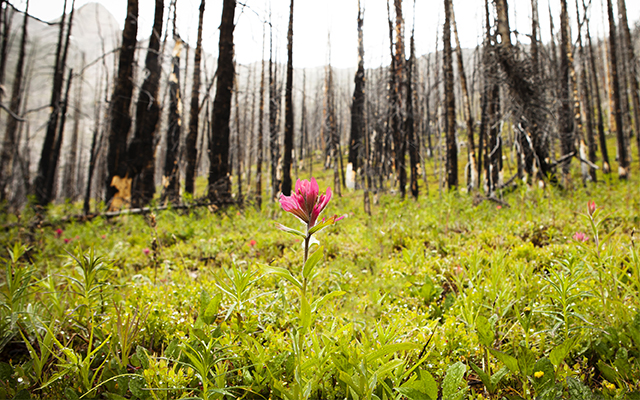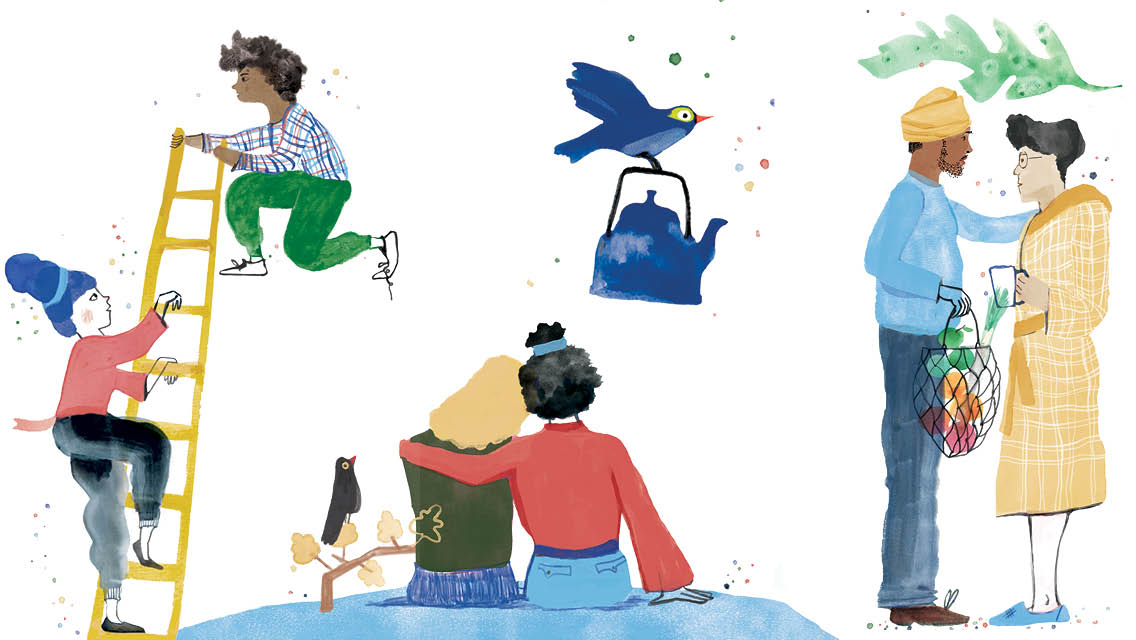I was sitting at a small table in a New York City apartment with a couple named Sarah and Raúl and two women named Christine and Sandy. I had arrived two and a half hours earlier at this potluck affair with wine, chips and guacamole, and an apple pie, prepared to talk about death and grief.
Most people probably don’t consider this appropriate table conversation. But in cities across the United States, an online organization called The Dinner Party brings together adults who have experienced the unexpected death of a loved one to break bread and discuss how the loss has affected their lives. I haven’t experienced a loss like theirs; I’m a journalist who studies meaning, and I was invited to dinner to observe how people come together to forge meaning and grow through suffering.
Many of us may not have suffered the loss of a loved one, but we all carry around emotional baggage of some kind — baggage that can bring with it fear, hurt, guilt, and insecurity. At least one specific source of pain lives inside each of us and colors the way we see the world: the memory of an alcoholic mother or an abusive father, the pain of being bullied at school, the horror of losing a child, the trauma of being raped, the helplessness of being held hostage by depression, cancer, addiction, or other ailments of the mind and body. These experiences of suffering can be tremendously difficult to overcome.
They also pose serious threats to finding meaning in life. They can shatter our fundamental assumptions about the world — that people are good, the world is just, and our environment is a safe and predictable place. They can breed cynicism and hatred. They can lead us to have troubled relationships, to lose our sense of identity and purpose, to abandon our faith, to conclude that we don’t matter or that life is senseless.
But this is an incomplete picture of adversity. Traumatic experiences can leave deep, some-times permanent wounds. Yet struggling through them can also push us to grow in ways that ultimately make us wiser and our lives more fulfilling.
We do so by relying on what I call the four pillars of meaning: belonging, purpose, storytelling, and transcendence. If these pillars are strong, we’ll be able to lean on them when adversity strikes. And even if the pillars crumble because of a shattering trauma, we can rebuild them to be even stronger and more resilient. (Learn more about these four pillars of meaning at “Toward a Meaningful Life.“)
This is what I saw Sarah, Raúl, Christine, and Sandy doing as we sat around the dinner table on that autumn evening.
Hearing them speak — sometimes angrily, sometimes sadly, sometimes with deep remorse and guilt — I was struck by how they were struggling to understand their losses. A couple of them were further along the road to recovery than the others, but each was leaning on some, if not all, of the pillars of meaning. They were forming a community. They were figuring out what their purpose was in light of the loss. They were trying to make sense of what had happened, and they were participating in a ritual that helped them step outside the hustle of their daily lives to find peace.
They were finding the meaning in their losses.
We’re often told that happiness is the key to the good life. Yet my research has taught me that meaning is the more powerful factor — and adversity plays an important role in finding it.
Be of Service
Since ancient times, literature, religion, and philosophy have shown how adversity can help us grow and lead deeper and more meaningful lives. Until recently, though, many psychologists considered trauma primarily a catastrophic stressor.
One of the characteristics of trauma, they believed, was that it damaged a person psychologically and physically, sometimes to the point of incapacitation. In 1980 the American Psychiatric Association added posttraumatic stress disorder (PTSD) to the Diagnostic and Statistical Manual of Mental Disorders, which is used to diagnose mental disorders. Since then, PTSD has received a great deal of attention from psychologists, the media, and ordinary people trying to understand what happens to people after a crisis.
Vietnam veteran Bob Curry’s story is a good example. Curry grew up in a blue-collar neighborhood in Milwaukee, Wis., the kind of place, he says, where people eat a lot of apple pie and watch a lot of John Wayne movies. As a child, he took to heart the lesson of John F. Kennedy’s inaugural address. “Whatever your country asks of you,” Curry remembers thinking, “you do it.”
When Curry was a teenager, Vietnam War protests were at their height. Even so, Curry felt a strong call to serve his country.
During the war, he flew reconnaissance missions over North Vietnam and Laos. It was a harrowing experience, he says. Enemy fire often bombarded his plane, and he nearly died on several occasions.
The terror of war experiences never left him, nor did the guilt of surviving when so many others died. He returned home in 1971 a different man. He tried leading a relatively normal life — starting a family, buying a home, and working for IBM. He had some flashbacks, but he largely managed to bury his guilt and fear.
In 1991, graphic depictions of the Gulf War on television and in newspapers brought him right back to Vietnam. He started drinking heavily. After the 9/11 attacks, his flashbacks intensified, and so did his drinking.
After a bender in 2002, Curry woke up in a hospital; two police officers stood next to his bed. They told him he had hit and killed a man with his car.
He was acquitted after being diagnosed with PTSD and was sent to a state mental institution, where he ruminated on how much destruction he had caused. Curry considered ending his life, but realized he had been given a second chance.
He began visiting the local VFW and found a safe space in which he could bond with people who had endured similar experiences and were dealing with similar consequences. Finding acceptance among his peers led him to ponder creating bonding opportunities for his fellow veterans that didn’t revolve around drinking.
In 2008 he and some friends launched Dryhootch, a community center for veterans that includes a coffee shop and offers live music, reading groups, art classes, and therapy sessions. Today, Dryhootch has six locations in Wisconsin and Illinois, including Madison and Chicago.
The drunk-driving accident forced Curry to turn inward — to figure out what he could contribute to the world. “Service is the only thing that makes sense after what happened,” he says. “I can’t undo time, but I can make a difference, and that’s what drives me forward.”
Posttraumatic Growth
Most people have heard about how PTSD can unravel a person. Fewer have heard about posttraumatic growth, the process that lifted Curry out of his despair and into his new role as a leader in the veteran community.
The term — defined as “positive change that occurs as a result of the struggle with highly challenging life crises” — was coined in the mid-1990s by Richard Tedeschi, PhD, and Lawrence Calhoun, PhD, after studying how people develop wisdom.
After speaking to an array of trauma survivors, Tedeschi and Calhoun found that suffering could help people transform in fundamentally positive ways — and that these transformations were both more profound and more common than either of them expected.
They identified five specific ways people can grow after a crisis:
First, their relationships strengthen. One woman diagnosed with breast cancer, for example, said she realized her relationships “are the most important things you have.” Bereaved parents told Tedeschi and Calhoun that losing a child had made them more compassionate.
Second, they discover new paths and purposes in life. Sometimes these are related to a particular survivor mission. One interviewee became an oncology nurse after losing her child to cancer. Other times, the crisis becomes the catalyst for a more general reconsideration of priorities, as Christine discovered when she started attending The Dinner Party in the aftermath of her mother’s death.
Third, the trauma allows them to find their inner strength. The common thread among those Tedeschi and Calhoun studied is a “vulnerable yet stronger” narrative. This paradoxical outlook defined the attitude of a rape survivor who admitted the world seemed more dangerous after the assault, but that, at the same time, she felt more resilient as a result of the inner strength she’d built.
Fourth, their spiritual life deepens. That could mean they renew their faith in God, or it could mean they grapple with existential questions more broadly, coming to know certain deep truths about the world or themselves, as one interviewee did after his spinal-cord surgery.
Finally, they feel a renewed appreciation for life. Rather than taking for granted a stranger’s kindness or the vivid colors of autumn leaves, they savor the small moments of beauty that light up each day.
Tedeschi and Calhoun discovered that the nature and severity of the trauma are less of a factor in posttraumatic growth than two other variables: how people interpret what happened to them and the degree to which the trauma upends what they believe about themselves and the world.
The difference between those who are able to grow from adversity and those who are stymied lies in what Tedeschi and Calhoun call “deliberate rumination” or introspection. The participants they studied spent a lot of time trying to make sense of their painful experiences, reflecting on how the events changed them. Doing so helped them make the life changes associated with posttraumatic growth.
But what distinguishes the resilient from the rest?
After extensive interviews with survivors of abduction, rape, and prisoners-of-war captivity, Steven Southwick, MD, of the Yale School of Medicine, and Dennis Charney, MD, of the Icahn School of Medicine at Mount Sinai, noted that those who emerged from their traumas bent but not broken shared similar characteristics.
Resilient people had a purpose, a worthy goal, or a mission in life — and a moral compass tied to altruism and serving others.
First, these resilient people had a purpose, a worthy goal, or a mission in life — and a moral compass tied to altruism and serving others.
Beyond purpose, social support is another critical predictor of resilience. For children, especially, a healthy relationship with an adult or caregiver can buffer the harmful effects of adversity.
Transcendent sources of meaning, such as a spiritual connection, also play a role in helping people cope with trauma.
As much as we might wish, none of us will go through life without some kind of suffering. That’s why it’s crucial to learn to suffer well. Those who manage to grow through adversity do so by leaning on the pillars of meaning — and afterward, those pillars are even stronger in their lives.
How to Build a Meaningful Life
Smith’s four pillars of meaning — belonging, purpose, storytelling, and transcendence — can help victims recover from severe trauma. They can also aid anyone dealing with the stresses of daily life. These strategies for nurturing the four pillars can guide you through times of adversity.
- Write about your experiences, emotions, and thoughts regarding the causes and consequences of the trauma. Research shows that those who write about their lives make better sense of their stories, report better grades, display fewer symptoms of anxiety and depression, and enjoy more powerful immune systems.
- Cultivate a sense of belonging. Feeling part of a larger purpose is vital to finding meaning. A survey of 28 janitors at a large Midwestern hospital found that when they felt doctors or nurses acknowledged rather than devalued them, they began to see their work as meaningful. Many even started to view themselves as caregivers.
- Adopt a “meaning” mindset. High school students who believed their studies would allow them to fulfill a life purpose earned better grades in math and science several months later. (For more on the power of mindset to help you build resilience, see “Change Your Mindset.”)
- Experience awe. Highly resilient people tap into sources of strength and power greater than themselves. One study noted that college students who spent one minute viewing a grove of 200-foot-tall trees became more altruistic than those who spent a minute looking at a tall building. Awe-inspired people feel a diminished sense of their own importance, researchers concluded, which leads them to be more generous. (For more on awe, visit “Awestruck.”)
This originally appeared as “Through the Fire” in the January-February 2018 issue of Experience Life.




This Post Has 0 Comments